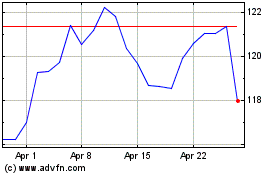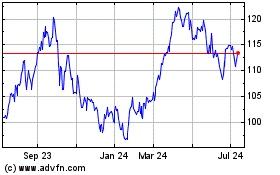Exxon Mobil Turns to U.S. Shale Basins for Growth
March 01 2017 - 11:44AM
Dow Jones News
By Bradley Olson
Exxon Mobil Corp. on Wednesday outlined an ambitious plan to
turn to prolific U.S. shale basins for growth, showcasing how the
oil giant now sees American production as a key to its future.
The company plans to spend about a fourth of its 2017 budget --
about $5.5 billion -- drilling in Texas, New Mexico and North
Dakota, tapping a vast inventory of wells that can turn a profit at
a price of $40 a barrel.
The U.S. increasingly appears at the center of a burgeoning
global revival after prices rebounded modestly and companies such
as Exxon have improved in their ability to profit due to lower
costs and feats of engineering.
Yet unlike some peers that plan to keep investment roughly flat
in future years, Exxon plans to increase spending to an average of
$26 billion a year from 2018 to 2020. The company plans $22 billion
in investments this year.
"Our job is to compete and succeed in any market, irrespective
of conditions or price," new Chief Executive Darren Woods said at
Exxon's analyst meeting in New York. It is his first major
appearance since taking over for Rex Tillerson, who stepped down to
become President Donald Trump's secretary of state.
"The ultimate prize in the Permian is significant," he said,
noting that the land the company controls in the West Texas and New
Mexico oil region may hold the equivalent of as much as 6 billion
barrels of oil and natural gas. The company also plans to invest in
Guyana, where it made a major discovery in 2015.
He also warned that because shale drilling has the ability to
ramp up more quickly than other kinds of production, it has the
potential to "temper" price volatility.
Mr. Woods, a 52-year-old engineer who rang the bell Wednesday
morning on the New York Stock Exchange, inherited an array of
challenges at the world's largest publicly traded energy company.
Debt has soared in recent years. Growth continues to be elusive.
Returns in Exxon's oil-and-gas production business are at the
lowest levels in decades.
Activists are targeting the company over whether it concealed
its prior knowledge of climate change, charges Exxon has denied and
said are part of a conspiracy by antagonists to smear its
reputation. Some investors meanwhile have grown enamored of smaller
producers with a longer record of stopping and starting production
on a dime in U.S. shale fields.
That is a comedown from Exxon's exalted status a decade ago,
when the company was a Wall Street darling, the biggest and most
profitable publicly traded corporation in the world. In 2007, Exxon
generated more than $40 billion in profits, then a record, most of
which came from oil-and-gas drilling in many of the world's
continents.
The recent crash in oil prices has exposed weaknesses in a
record of stable profits and returns that was once unimpeachable.
Net income last year was $7.8 billion, the lowest since 1996,
before Exxon bought rival Mobil Corp. for $82 billion in 1999.
Exxon's debt has risen as the company increased borrowing to pay
for dividends, one of several factors that prompted Standard &
Poor's Global Ratings last year to take away the triple-A credit
rating it had held since the Great Depression.
Some analysts are urging Mr. Woods, whose rise at the company
occurred within Exxon's sprawling network of refineries and
chemical plants, to shake up the cloistered descendant of John D.
Rockefeller's Standard Oil.
Exxon has lost cachet among institutional investors in recent
years: Most portfolios hold a smaller proportion of Exxon stock
than its relative size in the S&P 500 index, according to
Evercore ISI analyst Doug Terreson.
This "underscores investor concern" over Exxon's strategy, Mr.
Terreson wrote in February, arguing that the company should make
returns a priority over growth, a move taken up by peers including
Chevron Corp. and Royal Dutch Shell PLC.
Many analysts believe Mr. Woods is the perfect person to put the
company on a new course. Identified years ago as a future leader
through Exxon's meticulous process of winnowing its management
ranks, Mr. Woods was an architect of a yearslong effort that
reduced Exxon's footprint as a global fuel processor, according to
people familiar with his work.
He helped lead an effort to sell refineries or gas stations that
were less profitable and less interconnected with Exxon's other
operations. As he occupied various leadership roles in those
businesses, Exxon shaved off 1.3 million barrels a day of refining
capacity, about a fifth of the total in 2007. The company sold off
thousands of gas stations from Japan to Canada.
Mr. Woods, a staunch advocate of "integration," or the effort to
squeeze money from every aspect of the business -- including
producing, shipping, refining and processing oil and gas -- turned
to investments that would provide numerous options for turning a
profit. Those include equipment allowing a refinery to process
heavier crude that is cheaper than other grades, or making more
chemicals or niche products that can be sold at a premium.
Write to Bradley Olson at Bradley.Olson@wsj.com
(END) Dow Jones Newswires
March 01, 2017 11:29 ET (16:29 GMT)
Copyright (c) 2017 Dow Jones & Company, Inc.
Exxon Mobil (NYSE:XOM)
Historical Stock Chart
From Mar 2024 to Apr 2024

Exxon Mobil (NYSE:XOM)
Historical Stock Chart
From Apr 2023 to Apr 2024
